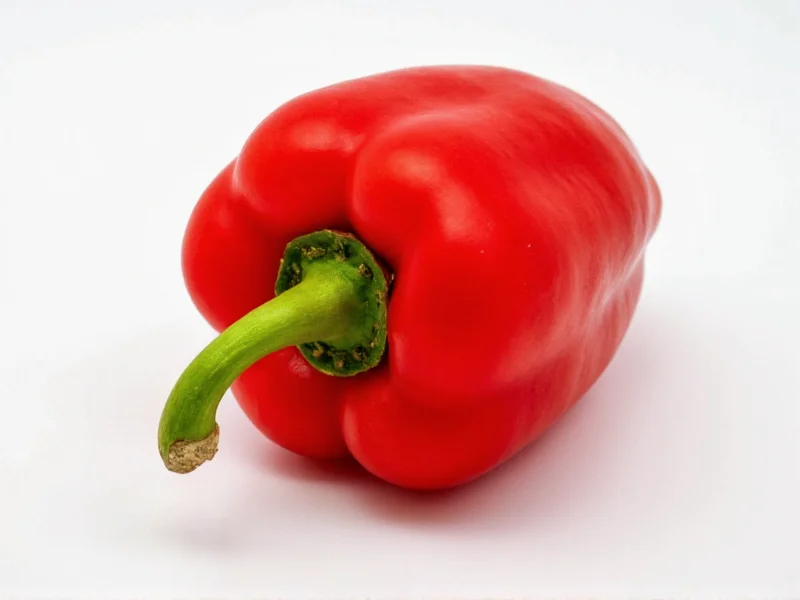When searching for the sweetest pepper variety, understanding how sweetness is scientifically measured is crucial. Unlike hot peppers that are rated on the Scoville scale for capsaicin content, sweet peppers are evaluated by their sugar concentration using the Brix scale. This measurement reflects the percentage of sucrose by weight in the pepper's flesh, providing an objective standard for comparing sweetness across varieties.
The Science Behind Pepper Sweetness
Sweetness in peppers develops as they mature on the plant. Green bell peppers are actually unripe versions of what will become red, yellow, or orange peppers. As peppers ripen, chlorophyll breaks down while carotenoids develop, and crucially, sugar content increases significantly. This ripening process explains why red bell peppers consistently test higher for sweetness than their less mature counterparts.
The transformation from green to red involves complex biochemical changes. During ripening, starches convert to simple sugars, particularly fructose, which our taste buds perceive as sweet. Additionally, certain compounds that contribute to bitterness in immature peppers decrease as the pepper matures. This dual process—increasing sugars while decreasing bitter compounds—creates the pronounced sweetness characteristic of fully ripe red peppers.
Comparing Sweet Pepper Varieties
While all bell peppers become sweeter as they ripen, specific cultivars have been selectively bred for exceptional sweetness. Understanding these differences helps gardeners and cooks select the perfect pepper for their needs. The following table compares popular sweet pepper varieties based on scientific measurements of sugar content:
| Pepper Variety | Color Stage | Brix Level (°) | Flavor Profile | Best Uses |
|---|---|---|---|---|
| Bell Pepper (Capsicum annuum) | Red (fully ripe) | 7-9 | Balanced sweet with subtle fruit notes | Raw applications, salads, roasting |
| Corno di Toro Rosso | Red | 8-9 | Exceptionally sweet, mild fruitiness | Grilling, stuffing, fresh eating |
| Bell Pepper | Yellow/Orange | 5-6 | Moderately sweet, slightly tangy | Stir-fries, stuffing, roasting |
| Bell Pepper | Green | 3-4 | Grassy, slightly bitter | Cooking, frying, pickling |
| Cubanelle | Yellow/Green | 5-6 | Mildly sweet, delicate flavor | Frying, sautéing, sandwiches |
| Banana Pepper | Yellow | 4-5 | Mildly sweet with slight tang | Pickling, sandwiches, salads |
Why Red Bell Peppers Reign Supreme in Sweetness
Among all commonly available sweet peppers, fully ripe red bell peppers consistently demonstrate the highest sugar content. Agricultural studies from university extension programs confirm that red bell peppers contain approximately 50% more sugar than yellow or orange varieties and nearly double the sugar content of green bells. This significant difference explains why professional chefs often specify red bell peppers in recipes where sweetness is essential.
Several factors contribute to the superior sweetness of red bell peppers:
- Extended Ripening Time: Red peppers remain on the plant longest, allowing maximum sugar development
- Carotenoid Development: As chlorophyll breaks down, carotenoids increase, correlating with sugar accumulation
- Starch Conversion: More time on the plant allows complete conversion of starches to simple sugars
- Bitter Compound Reduction: Compounds like capsidiol decrease significantly during full ripening
When selecting peppers for maximum sweetness, look for deep, uniform color, firm flesh, and a smooth, glossy skin. Peppers with three or four lobes at the base often contain more seeds and may be slightly sweeter than those with two lobes, though this varies by cultivar.
Maximizing Sweetness in Your Peppers
Whether you're growing your own or selecting from the market, several techniques can help ensure you get the sweetest possible peppers:
For Gardeners: Allow peppers to fully ripen on the plant until they develop their mature color. Maintain consistent moisture (but avoid overwatering), provide adequate potassium which supports sugar production, and harvest in the morning when sugar content peaks. Certain varieties like 'Ace', 'Gypsy', and 'Lipstick' have been specifically bred for exceptional sweetness.
For Shoppers: Choose peppers with deep, vibrant color and heavy weight for their size. Avoid peppers with wrinkles, soft spots, or dull skin. Store peppers in the crisper drawer of your refrigerator for up to two weeks, though sweetness may gradually decrease over time. For peak sweetness, use within 3-5 days of purchase.
Culinary Applications for Sweet Peppers
The pronounced sweetness of red bell peppers makes them ideal for applications where sugar content enhances the final dish. Raw preparations showcase their natural sweetness best, as cooking can sometimes diminish delicate flavor compounds. Try thinly sliced red bell peppers in salads, on charcuterie boards, or as the base for fresh salsas.
When cooking, gentle methods like quick sautéing or light roasting preserve sweetness better than prolonged high-heat cooking. Red bell peppers pair beautifully with ingredients that complement their natural sugars, including balsamic vinegar, fresh herbs like basil and oregano, citrus zest, and mild cheeses like fresh mozzarella.
For those exploring which bell pepper color is sweetest for specific recipes, red bells work exceptionally well in dishes where sweetness is the star, while yellow and orange varieties offer a more moderate sweetness that blends well in mixed applications. Understanding these subtle differences helps home cooks make informed choices when selecting peppers for specific culinary purposes.











 浙公网安备
33010002000092号
浙公网安备
33010002000092号 浙B2-20120091-4
浙B2-20120091-4